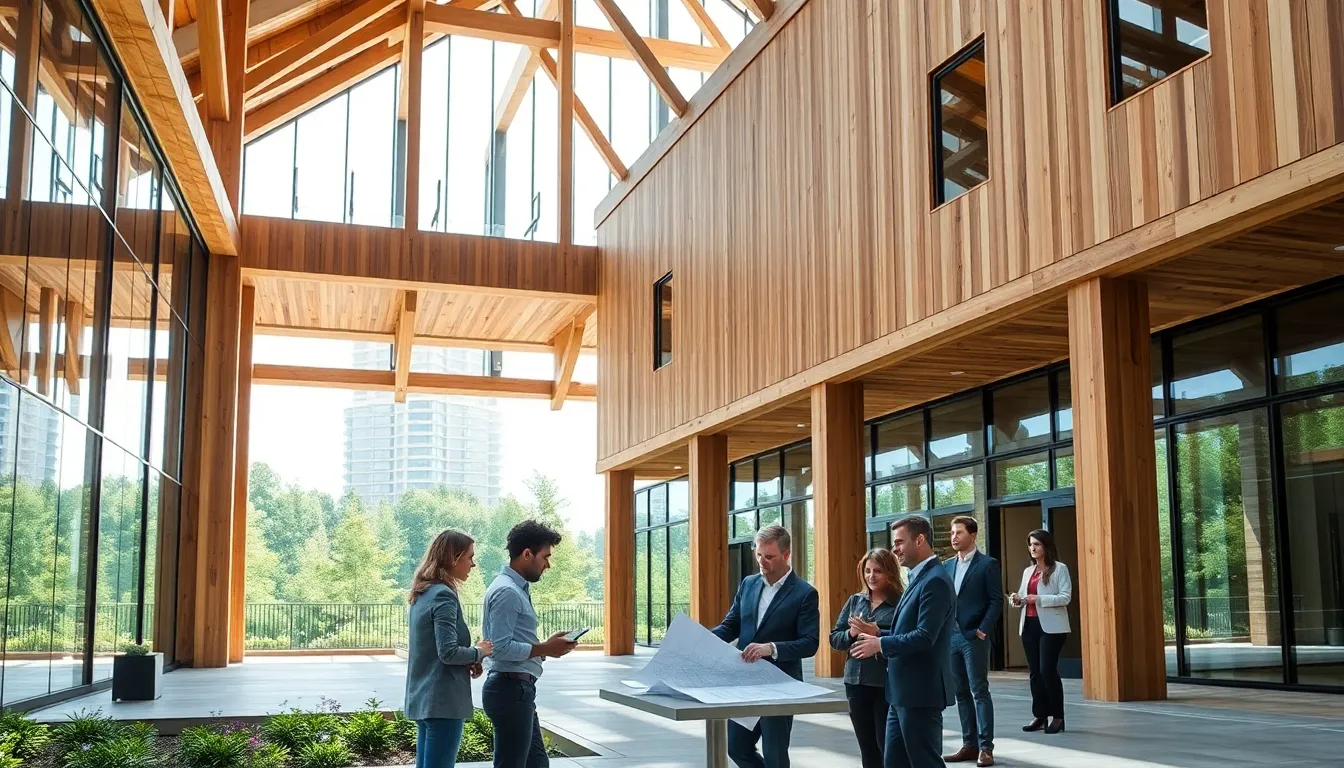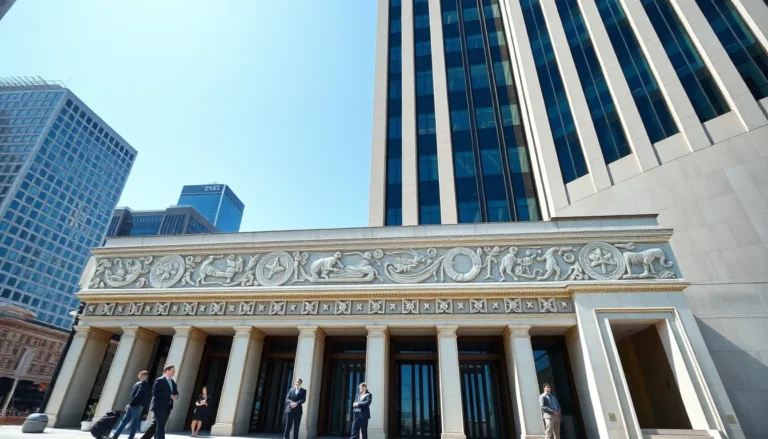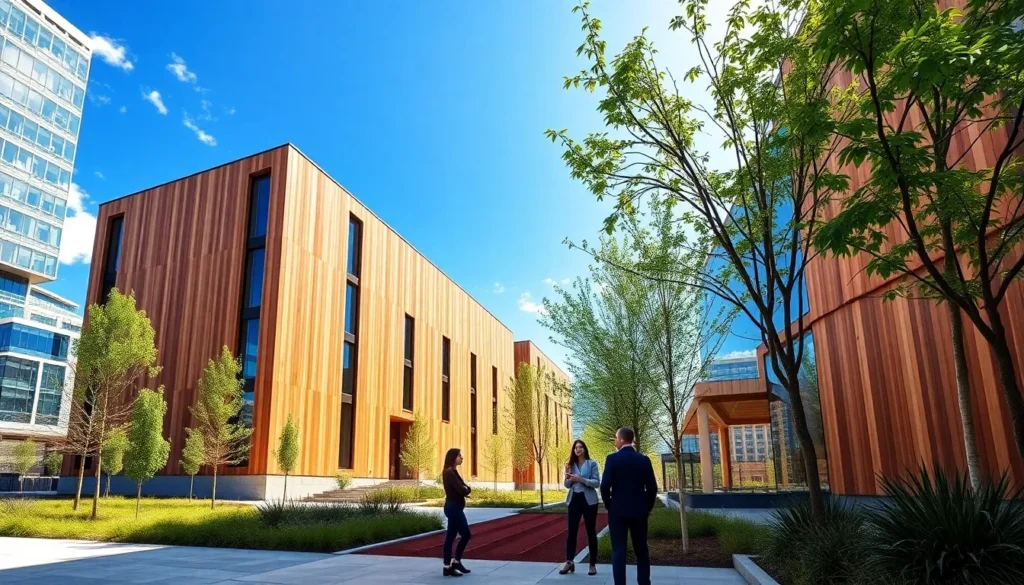Table of Contents
ToggleImagine a world where forests breathe life into our cities, replacing concrete jungles with warm, welcoming wood. Mass timber architecture is not just a trend: it’s a revolution. This innovative approach to building marries sustainability with modern design, allowing architects to create structures that are as aesthetically pleasing as they are eco-friendly. If you think wood is just for cozy cabins or playgrounds, think again. In this text, we’ll jump into the intriguing realm of mass timber and how it’s reshaping the future of architecture. Buckle up: it’s going to be a wooden adventure.
What Is Mass Timber Architecture?

Mass timber architecture refers to the use of large, solid wood panels or beams in structural applications. Unlike traditional timber framing that typically uses smaller pieces, mass timber leverages engineered wood products such as cross-laminated timber (CLT) or glulam (glue-laminated timber). These materials can span longer distances and support greater loads, eventually enabling the construction of mid-rise and high-rise buildings. Think of it as the architectural equivalent of leveling up: it allows for more creative and sustainable building designs without compromising structural integrity.
In simpler terms, mass timber architecture transforms wood into a versatile construction material that combines beauty, strength, and sustainability, all bundled into a smell that evokes walks in the woods.
Benefits of Mass Timber in Construction
The benefits of incorporating mass timber into construction are manifold. For starters, mass timber is an eco-friendly alternative to conventional building materials. It sequesters carbon, acting like a natural air filter and helping combat climate change. By choosing wood harvested from sustainably managed forests, it reduces the carbon footprint significantly compared to steel or concrete.
Also, mass timber structures offer excellent thermal performance. Wood naturally insulates, making buildings warmer in winter and cooler in summer. This leads to lower energy costs and a more sustainable living environment. Also, the aesthetic appeal of mass timber is hard to overlook: the warmth and beauty of wood create inviting spaces that enhance overall well-being. Let’s not forget about construction speed either, because mass timber components can be prefabricated off-site, overall project timelines can be shortened.
Design Principles of Mass Timber Structures
Designing mass timber structures involves a rethinking of traditional architectural principles. It requires harmonizing the natural characteristics of wood with modern design techniques. Architects often adopt a modular approach, using standard sizes of laminated panels that interconnect seamlessly. This encourages an efficient use of materials, leaving minimal waste in its wake.
Another design principle to consider is the relationship between indoor spaces and nature, often referred to as biophilic design. Mass timber’s warm aesthetic creates a connection with the outdoors, think large windows that frame breathtaking views or open spaces that incorporate living trees. The result? Structures that not only look good but feel good. Finally, ensuring proper detailing and connections between timber elements is crucial to achieving structural stability: it’s a bit like a puzzle where each piece has to fit just right.
Challenges in Mass Timber Architecture
Even though its many advantages, mass timber architecture is not without its challenges. Fire safety is often at the top of the list: while wood does burn, the char layer that forms on the outer surface can actually protect the inner core, enhancing fire resistance. But, regulations vary, and this can hinder widespread adoption.
Also, there are perceptions around durability and maintenance. While mass timber structures can last for decades with proper care, they may require more upkeep compared to their concrete counterparts. Working within local building codes can also prove tricky, particularly in areas where traditional materials are favored.
Weather considerations pose another obstacle: wood is susceptible to moisture and insect damage. Architects and builders must adopt appropriate treatment methods and use design strategies that mitigate these risks.
Innovative Examples of Mass Timber Projects
There are breathtaking examples of mass timber architecture blooming around the world. Take the Dalston Works in London, which showcases a remarkable use of cross-laminated timber. This seven-story structure stands not only as the largest CLT building in the UK but also as a symbol of sustainable living, a perfect blend of innovation and style.
Another stunning project is the T3 Building in Minneapolis. Its name, short for Timber, Technology and Transit, reflects its purpose. Here, the harmonious integration of mass timber elements creates an inviting workspace that’s as functional as it is beautiful. These projects are just a glimpse into the potential of mass timber to redefine urban landscapes: they inspire architects and builders to imagine what’s possible when they dare to break the mold.
The Future of Mass Timber Architecture
As we look toward the future, the role of mass timber architecture continues to expand. Sustainable building practices are no longer just a suggestion: they’re becoming a necessity as climate change demands innovation. With advances in technology and a growing body of research supporting its benefits, mass timber has the potential to be a game-changer in sustainable design.
Plus, as more architects embrace the idea, mass timber could become a standard in urban development. Cities are beginning to recognize the importance of green building practices, from reducing their carbon footprint to improving occupant health. Just picture an urban environment dotted with majestic, wooden skyscrapers, reflecting a new era of architecture that harmonizes with nature. The future is bright, and it’s looking a little more wooden.







